Native Son – June, 2012
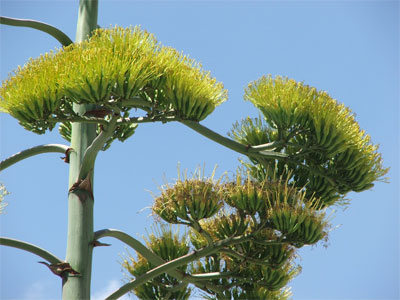
Century plant flowers begin to wither after successful pollination. Photos by Steven Chamblee except where otherwise noted.
Death of the Century and Life Immortal
I think someone is trying to tell me something. Yesterday afternoon, I was driving down little ol’ Garner Road and headed into the zig-zag curve, when I found myself staring at the grill of a red truck … in my lane. It all happened so fast that I didn’t have time to honk or holler sweet things into the air, so I just headed off into the bar ditch. Fortunately, it was shallow and I stopped before I hit the pipe fence, but I did have the vision of the other driver still floating in my mind … head bowed down, staring into a cell phone. Of course, the driver didn’t stop. Probably never saw me. I sat there a minute, gathering myself amidst the dust cloud, wondering if they ever wondered how that little white truck in the rear-view mirror got in that ditch. I quickly realized I was being ridiculous — why would they ever use the rear-view mirror to see where they’ve been when they don’t bother to use the windshield to see where they’re going?
Of course, I hadn’t driven another mile when I got to thinking about the realm of possibilities. Perhaps I’m actually “gone” and floating through the afterlife. Perhaps I’m just dreaming. Perhaps that was some sort of divine wake-up call. Up ahead, I see a large doe run across the road in broad daylight. Hmmm … I’m going with Door #3.
Neither the near-death experience nor the rear-view mirror/windshield metaphor was wasted on me. I got up to see the sun rise and walk the pasture. I phoned a friend just to say, “I love you.” I ate some salad. And I made a little time to go visit a giant century plant that’s thrown up a monster blossom.
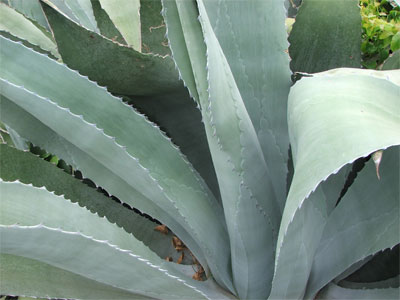
The thick, succulent leaves of the century plant unfurl from a central core. They often show the imprint of adjacent leaves, a trait called “ghosting.”
Century plant (Agave americana) is native to Mexico, but has been cultivated around the world long enough for many people to think it occurs naturally in their neck of the woods. It is an impressive plant: thick gray-green leaves, tough as leather and armed with stiletto tips and meat-ripping fishhooks along the margins, form a giant rosette up to 12 feet across. In spite of all of this toughness, which allows it to survive in arid regions all over the globe, it has a graceful loveliness to it, particularly when viewed from beyond the puncture zone. With adequate moisture it is a fairly fast grower and can reach full size within five years from seed, but it is usually propagated from vegetative shoots called “pups” that encircle the base of the plant. And despite that common name, “century plants” do not live 100 years. They usually complete their life cycle in about 10 to 30 years, depending upon growing conditions. But when it is their time to go, they do so with panache and gusto.
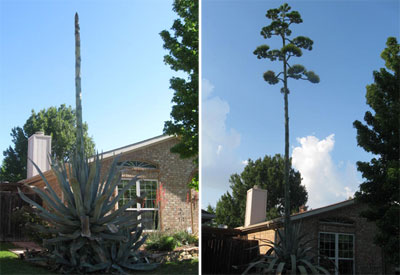
Left Photo: Sperry reader Laine Jones sent in a photo of her century plant on April 21. Right Photo: Just two months later, Laine’s century plant is in full flower. (Photos courtesy of Laine Jones.)
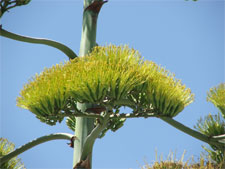
Yellow pistils and stamens create the yellow color of the petal-less blossoms.
Century plants flower only once, as they expend all of their energy into producing a giant flower stalk that rises to about 25 feet … and what a spectacle it is. Growing as fast as 5 inches per day, the prodigious peduncle stabs the sky like a giant, 5-inch-thick pencil, until it finally begins to form a candelabra-styled inflorescence of flowers. At first, the flower clusters look a bit like oval-shaped pods of lime-green AA batteries, all tightly-packed and standing on end, but the clusters soon produce a stunning halo of bright yellow flowers. Moths and hummingbirds pollinate the flowers, which mature into ripe fruits that don’t look too much different than the “pre-halo” flower clusters, except that the AA batteries have swollen into lime-green C batteries. Once the seed is mature, the whole stem, along with the “mother plant,” dies. The pups continue growing until they eventually flower and die, and the cycle repeats endlessly.
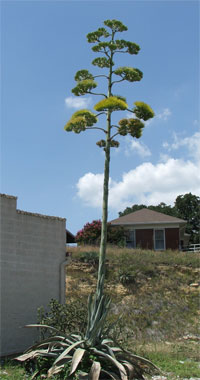
Ending the flowering cycle, this mother plant has already begun to wither.
This “all or nothing” reproduction technique is termed “semelparity,” and many plants use it, primarily annuals such as sunflowers and corn. Not many perennial plants are semelparous, but some exist, such as certain bamboos and other agave species. Animals can be semelparous too; Pacific salmon are perhaps the most famous example.
So all of this life and death stuff rolling around in my head brought back the memory of another life-changing moment. Fifteen years ago, I held my four-year-old son’s little hand while we watched The Lion King. We got to the “circle of life” part where daddy Mufasa was explaining to his young cub Simba about how everything that lives eventually dies, including lions. My son looked up at me with big, blue eyes and asked, “Should I be afraid to die?” I told him the only thing he should be afraid of is not really living. After a moment, he said, “Isn’t that the same thing?” As I struggled to find the words to explain what I meant, he turned to me and said, “I guess not.”
An hour later, the movie ends in a big thud and we are both clapping. He turns to me and says, “We’re really living now, huh Dad?”
Dad gummit … 15 years later, those words still make my eyes get soggy.
About the author: Steven Chamblee is the chief horticulturist for Chandor Gardens in Weatherford and a regular contributor to Neil Sperry’s GARDENS magazine and e-gardens newsletter. Steven adds these notes:
Things are really cooking at Chandor Gardens! Lunch in the Gardens with The Wild Mushroom. The Wild Mushroom restaurant staff has gained a reputation across the Metroplex for their outstanding cuisine, excellent service, and generous hospitality. Now they are bringing their special culinary talents to Chandor Gardens. Beginning Tuesday, July 10, please join us weekly on Tuesdays and Wednesdays from 11:30 a.m. to 1:30 p.m. for a unique dining experience. Reservations required — contact kelli@thewildmushroomrestaurant.com, or call 817-374-2697. Adults: $16. Children’s menu available on request. For a peek at the menu, go to www.thewildmushroomrestaurant.com. Then just take I-20 west to exit 409, hang a right, go 2.1 miles and hang a left on Lee Avenue. Head straight 12 blocks and you’re driving in the gates. Call 817-361-1700 for more information. You can always go to http://ci.weatherford.tx.us/index.aspx?nid=170 for a picture tour and details.
I can always use another road trip! Let me know if you’d like me to come out and speak to your group sometime. I’m low-maintenance, flexible, and you know I like to go just about anywhere. No city too big; no town to small. Just send me an e-mail at schamblee@weatherfordtx.gov and we’ll work something out.
